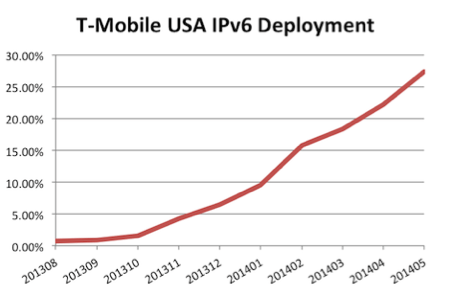T-Mobile in the United States was running out of IPv4 addresses and needed an IPv6 transition strategy. Their solution was 464XLAT and IPv6-only.
464XLAT is an IPv6 transition technology documented in RFC 6877, which builds on previous technologies such as NAT64 and DNS64. The problem for T-Mobile with just using NAT64 and DNS64 was that specific applications, such as Skype or Whatsapp, could not function through NAT64. By using 464XLAT T-Mobile was able to keep these applications working, and provide native IPv6 connectivity where possible.
After launching this solution on 8 million phones T-Mobile has seen 27% of all traffic on these phones be native IPv6, and as the graph below shows, that number is still growing. If your organization doesn’t have a plan yet for IPv6, what are you waiting for?

Check out the presentation from Cameron Byrne of T-Mobile US at NANOG 61, entitled “464XLAT Breaking Free of IPv4” embedded below. The slides and video are also available for download.
For more on NAT64, visit these instructional videos from RIPE-NCC on IPv6 transition technologies. Our own Jan Žorž also wrote a post about his experience using 464XLAT on a mobile network in Slovenia.
Please visit our IPv6 Case Studies page for more examples of IPv6 deployment. If you would like to get started with IPv6, please visit our IPv6 resources or begin with our “Start Here” page to help find resources most appropriate for your type of organization. If you have an IPv6 case study you think we should consider for inclusion on our site, please contact us – we are always looking for more!
